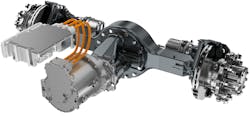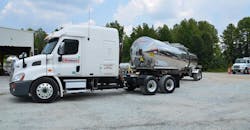Dana to provide e-propulsion for hydrogen fuel project
Dana Incorporated says its Spicer Electrified e-propulsion system with integrated TM4 SUMO HP motor-inverter will power Class 8 tractor-trailers moving freight year-round between Edmonton and Calgary in Alberta, Canada.
The trucks are part of a three-year, $11.2 million Alberta Zero-Emissions Truck Electrification Collaboration (AZETEC) project, which involves the design and manufacture of heavy-duty, extended-range, hydrogen fuel cell electric hybrid trucks.
Dana’s custom Spicer e-System is optimized for the Canadian market, with a hauling capacity of 140,000 pounds, the highest-rated electrified drivetrain system for linehaul applications, the company said. The system’s compact design reduces weight and allows for more hydrogen fuel storage, while high-speed helical gearing provides greater overall efficiency. Dana’s TM4 SUMO HP motor-inverter system was specifically designed for high-power applications and multi-speed gearboxes.
“Dana is pleased to have been selected as a key partner for this enterprising hydrogen fuel project,” said Mark Wallace, president of Dana Commercial Vehicle Driveline Technologies. “It marks another step in the innovation continuum as the industry transitions to zero-emission transportation. The consortium partners share a common vision in advancing clean technologies, and we welcome the opportunity to provide Spicer electrodynamic solutions as part of these collective efforts.”
The trucks, developed for Alberta’s unique operating environment, will be 70.5-ton B-train tractor-trailers capable of traveling up to 430 miles between refueling. They will be operated by Alberta trucking companies Trimac Transportation and Bison Transport. At the conclusion of the project, the trucks will have carried approximately 13.2 million ton-miles of freight.
The AZETEC project is expected to help ensure the continuation of a timely, efficient and cost-effective supply chain of goods.
AZETEC will test hydrogen as a zero-emissions alternative fuel to diesel for freight transportation, along with the refueling infrastructure and other systems that would be required for Alberta to implement this new solution. The three-year project also will investigate the potential to reduce greenhouse gas emissions and airborne pollutants.

